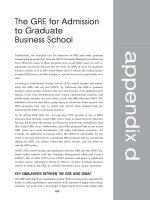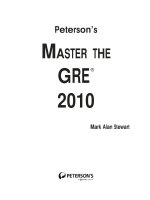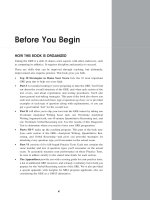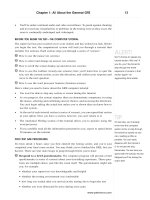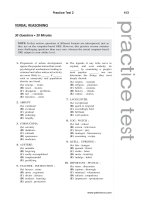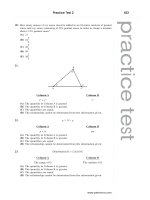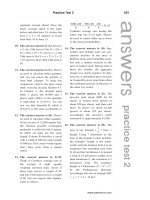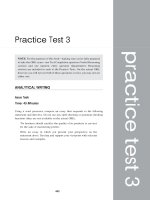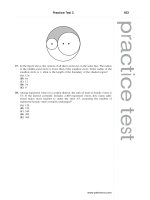Tài liệu Master the Gre 2010 - Part 57 pdf
Bạn đang xem bản rút gọn của tài liệu. Xem và tải ngay bản đầy đủ của tài liệu tại đây (53.74 KB, 10 trang )
Practice Test 6
NOTE: For the purposes of this book—making sure you’re fully prepared
to take the GRE exam—one Text Completion question (Verbal Reasoning
section) and one numeric entry question (Quantitative Reasoning
section) are included in each of the Practice Tests. On the actual GRE,
however, you will not see both of these questions; in fact, you may not see
either one.
ANALYTICAL WRITING
Issue Task
Time: 45 Minutes
Using a word processor, compose a response to the following statement and
directive. Do not use any spell-checking or grammar-checking functions (they
are not available on the actual GRE):
“Most people are actually happier when they have fewer goods and
services from which to choose; this is especially true today, when we
are deluged with advertising as never before and from more sources
than ever before.”
Write an essay in which you assess the accuracy of the statement
above. Develop and support your viewpoint with relevant reasons
and examples and by considering ways in which the statement may
or may not be true.
practicetest6
....................................................................................
543
Argument Task
Time: 30 Minutes
Using a word processor, compose an essay that responds to the following argument and
directive. Do not use any spell-checking or grammar-checking functions (they are not
available on the actual GRE).
The following appeared in a memo from the principal of Harper Elementary
School to the school’s faculty and staff:
“In order to raise the level of reading skills of our students to a level that at
least represents the national average for students in the same age group, we
should adopt the ‘Back to Basics’ reading program. After all, according to the
company that created the program and provides it directly to elementary
schools throughout the country, Back to Basics has a superior record for
improving reading skills among youngsters nationwide. By adopting Back to
Basics, the parents of Harper Elementary School students would be assured
that their children will develop the reading skills they will need throughout
their lives.”
Discuss how well-reasoned you find the argument above.
PART VI: Five Practice Tests544
.................................................................
..............................................................................................
www.petersons.com
VERBAL REASONING
30 Questions • 30 Minutes
NOTE: In this section, questions of different formats are interspersed, just as
they are on the computer-based GRE. However, this practice session contains
more challenging questions than easy ones, whereas the actual computer-based
GRE adapts to your ability level.
1. TREMBLE : FEAR ::
(A) scream : envy
(B) smile : rage
(C) demand : anger
(D) follow : adoration
(E) weep : grief
2. WATERMARK : PAPER ::
(A) landmark : monument
(B) envelope : stamp
(C) character : novel
(D) badge : employee
(E) signature : author
3. The government’s _______ clinical
study requirements for new drugs do
not _______ pharmaceutical firms
when it comes to research and devel-
opment, chiefly because of the profit
potential afforded by patent pro-
tection.
(A) official..please
(B) onerous..dissuade
(C) extensive..impel
(D) unenforceable..favor
(E) vague . . prejudice
4. PROPRIETY:
(A) selfishness
(B) lack of decorum
(C) sensuality
(D) impudence
(E) lack of virtue
5. SCIENTIAL:
(A) ignorant
(B) intuitive
(C) stupid
(D) regressive
(E) gullible
6. CLOISTERED:
(A) extraverted
(B) extrapolated
(C) gregarious
(D) savvy
(E) dispersed
7. Recent advances in molecular
biology and genetics (i)_______ to the
position that as physical beings our
actions are determined by physical
forces beyond our control—the
age-old “determinist” viewpoint.
(ii)_______, this new research sug-
gests that such physical forces
include our individual genetic
makeup.
Blank (i)
lend credence
take exception
give rise
Blank (ii)
In fact
In addition
Specifically
8. COTTON : SOFT ::
(A) wool : warming
(B) wood : polished
(C)
nylon : strong
(D) iron : hard
(E) silk : expensive
9. FISH : AQUARIUM ::
(A) lions : den
(B) insects : ground
(C) automobile : garage
(D) stew : cauldron
(E) birds: aviary
practicetest
Practice Test 6 545
.................................................................
..............................................................................................
www.petersons.com
10. SPARK : CONFLAGRATION ::
(A) yeast : fermentation
(B) match : light
(C) drizzle : downpour
(D) sugar : sweetness
(E) volcano : eruption
11. Just as Mozart’s music broke new
ground in the world of classicism, so
Beethoven’s work _______ the
unspoken rules of the classical
period and _______ changes which
eventually led to romanticism.
(A) obeyed..implemented
(B) eradicated . . avoided
(C) conformed to . . supported
(D) evaded . . resisted
(E) overturned..initiated
Questions 12 and 13 are based on
the following passage.
In the 1970s, the idea of building so-
called “New Towns” to absorb growth was
considered a potential cure-all for urban
problems in the United States. It was
assumed that by diverting residents from
existing centers, current urban problems
would at least get no worse. It was also
assumed that, since European New Towns
had been financially and socially suc-
cessful, the same could be expected in the
United States.
In the end, these ill-considered projects
actually weakened U.S. cities further by
drawing away high-income citizens. While
industry and commerce sought in turn to
escape, the lower-income groups left
behind were unable to provide the nec-
essary tax base to support the cities. Not
surprisingly, development occurred in
areas where land was cheap and con-
struction profitable rather than where
New Towns were genuinely needed.
Moreover, the failure on the part of
planners and federal legislators to con-
sider social needs resulted not in the sort
of successful New Towns seen in Britain
but in nothing more than sprawling
suburbs.
12. The passage states that New Towns
in the United States
(A) spurred economic redevel-
opment in decaying urban
centers
(B) provided a thriving social
center away from the problems
of the older city
(C) provided affluent urban
residents an escape from the
city
(D) were different than those in
Great Britain in certain
important respects
(E) provided models for many of
today’s urban redevelopment
projects
13. Which of the following phenomena is
most closely analogous to the New
Towns established in the United
States?
(A) A business that fails as a result
of insufficient demand for its
products or services
(B) A new game that fails to attain
widespread popularity because
its rules are unfair
(C) A scientific theory that lacks
supporting empirical evidence
(D) A new drug that is never
approved for legal sale because
of its severe side effects
(E) A new computer program that
attempts to solve one software
problem but that creates
another
14. SATIATE:
(A) crave deeply
(B) deplete entirely
(C) be repelled by
(D) apply forcefully
(E) enjoy thoroughly
15. OSSIFIED:
(A) liquefied
(B) encrusted
(C) excavated
(D) deconstructed
(E) contaminated
PART VI: Five Practice Tests546
.................................................................
..............................................................................................
www.petersons.com
16. RECTITUDE:
(A) lack of self-confidence
(B) difference of opinion
(C) intellectual uncertainty
(D) moral weakness
(E) ethical dilemma
Questions 17 and 18 are based on
the following passage.
The amount of bone in the elderly skel-
eton—a key determinant in its suscepti-
bility to fractures—is believed to be a
function of two major factors. The first is
the peak amount of bone mass attained,
determined to a large extent by genetic
inheritance. The marked effect of gender
is obvious: Elderly men experience only
one-half as many hip fractures per capita
as elderly women. But also, African-
American women have a lower incidence
of osteoporotic fractures than Caucasian
women. Other important variables include
diet, exposure to sunlight, and physical
activity. The second major factor is the
rate of bone loss after peak bone mass has
been attained. While many of the vari-
ables that affect peak bone mass also
affect rates of bone loss, additional factors
influencing bone loss include physiological
stresses such as pregnancy and lactation.
It is hormonal status, however, reflected
primarily by estrogen and progesterone
levels, that may exert the greatest effect
on rates of decline in skeletal mass.
17. The passage clearly identifies all of
the following as factors in the rate of
bone-mass loss EXCEPT for
(A) lactation
(B) sunlight exposure
(C) progesterone levels
(D) pregnancy
(E) estrogen levels
18. It can be inferred from the passage
that the peak amount of bone mass
in women
(A) is not affected by either
pregnancy or lactation
(B) is determined primarily by diet
(C) depends partly upon hormonal
status
(D) may be a factor in the rate of
decrease in estrogen and
progesterone levels
(E) is not dependent upon genetic
makeup
19. Salinger’s Catcher in the Rye, having
become a manifesto for psychopaths
and potential miscreants, is viewed
by many high-school administrators
as too _______ to be suitable for
teenage students.
(A) austere
(B) insipid
(C) provocative
(D) aberrant
(E) progressive
20. INTERLOPER : MEDDLE ::
(A) misanthrope : usurp
(B) rogue : repent
(C) advocate : espouse
(D) dilettante : proselytize
(E) ombudsman : refine
21. WALK : AMBLE ::
(A) work : tinker
(B) play : rest
(C) run : jump
(D) jog:trot
(E) disperse : leave
22. SENSATION : PARALYSIS ::
(A) sincerity : dishonesty
(B) obesity : diet
(C) insult : injury
(D) apathy : curiosity
(E) scarcity : surplus
practicetest
Practice Test 6 547
.................................................................
..............................................................................................
www.petersons.com
